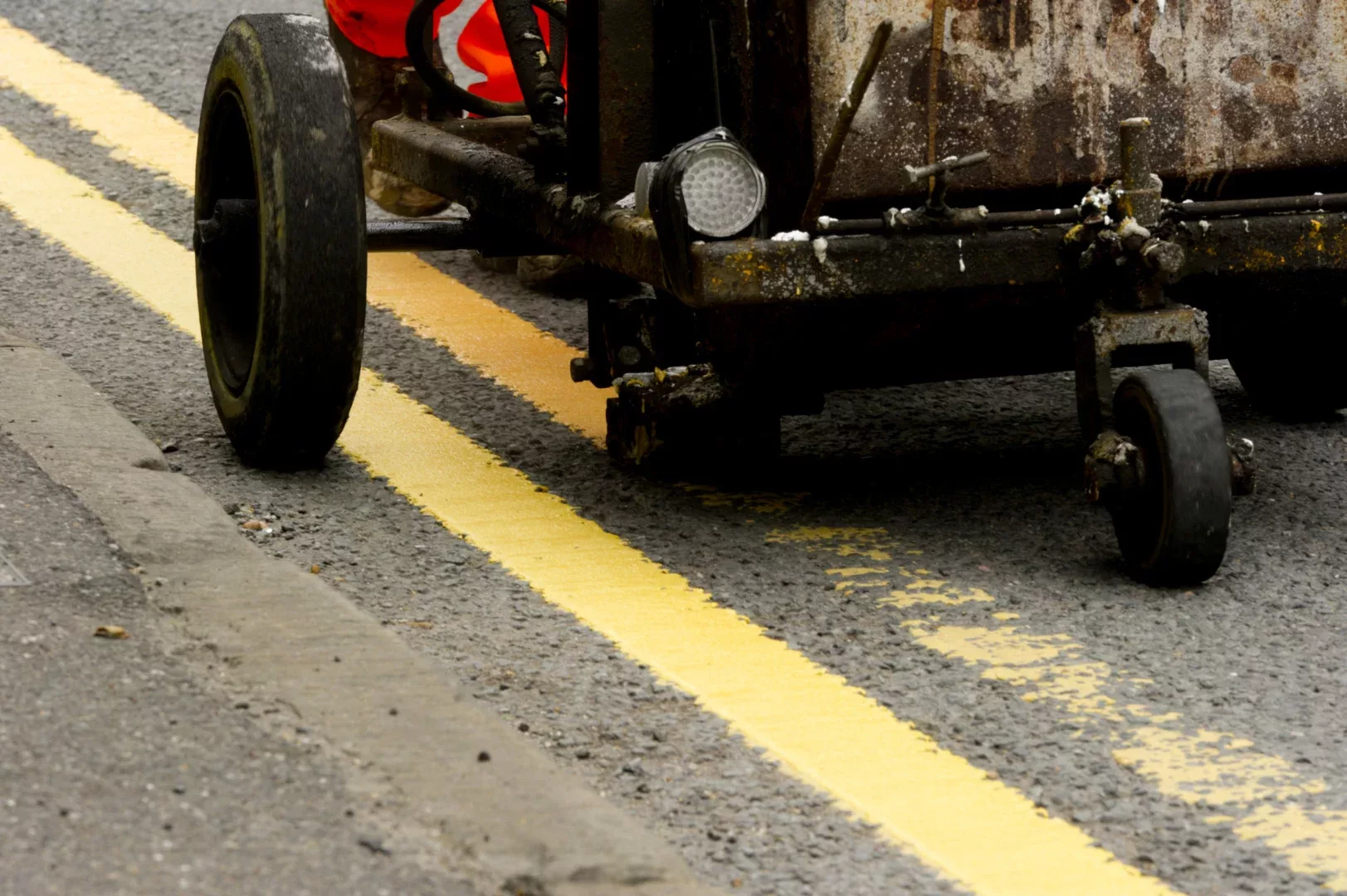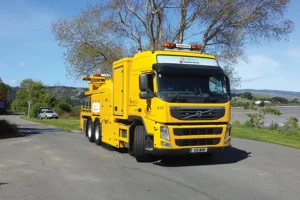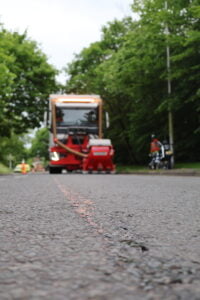The safety benefits of road markings are well documented. They are the most cost-effective measure to improve and maintain safety standards on the road at any given time, at a fraction of the cost of any other road infrastructure alteration. What is less well documented is the environmental benefits road markings provide when they are maintained to a high standard.
It’s a well-known fact that transport is the biggest contributor to greenhouse gases and the move away from fossil fuels is going to be a major factor in combatting this. Clean air zones in congested areas and a rise in electric vehicles and charging points is being seen across the globe, but there is still a long way to go.
To become carbon neutral (or as close as can be) it is time for the Department of Transport and road authorities to invest in the country’s road marking infrastructure. Clear, visible, professionally installed, reflective road markings benefits all of us. It results in roads and road users being safer, therefore less risk of collisions and also keeps traffic moving. Keeping the flow of traffic moving removes idle engines and in turn reduces emission hotspots and contributes to cleaner air.
There is a direct correlation between improving the safety standards and layout of roads through improved and well-maintained road markings and a reduction in vehicular emissions. Where there is room to accommodate, road markings can be installed to allow for a turn-lane to be incorporated; this provides an area for vehicles to slow down and wait before turning across traffic into side roads, taking the road user out of the flow of traffic, reducing a build-up of traffic. Similarly, yellow box-junctions can be installed on busy intersections and signal-controlled roundabouts to allow for the continued movement of traffic from all directions.
To further reduce vehicular emissions, the Government must persuade the public to not use vehicles as often and take-up alternative methods of transport. Promoting active travel as an alternative is an attractive option, but to encourage greater participation in cycling and walking, investment needs to be made in the infrastructure. Road markings form the basis of any active travel infrastructure, allowing for segregated, demarcated travel lanes, allowing cyclists to ride where they feel safer and more confident, out of the way of passing motorists. Road markings and demarcated cycle lanes will encourage an increase in the number of cyclists, a reduction in vehicular traffic and ultimately, a reduction in vehicular emissions. Investment in active travel infrastructure and demarcated cycle lanes will result in highway authorities achieving reductions in both congestion and vehicular emissions.
If the UK Government is serious about being a world leader in autonomous vehicles (AVs), then investments in road marking infrastructure must be made. There is a clear divide in road marking infrastructure across the country; the strategic road network, where generally, the road marking infrastructure is maintained to a reasonable standard, and the local road networks, where unfortunately, the road marking infrastructure is all-to-often below an acceptable standard.
Without performing and well maintained road markings, AVs will not function; if it is not functioning, it will not be driven as efficiently as it could be and those safety and environmental benefits are lost. When fully-autonomous vehicles do arrive on our shores, change will not be immediate and will likely result in a mixed fleet of vehicles for the foreseeable future, consisting of human-controlled, vehicles with advanced driver assistance systems (ADAS) and fully autonomous. In this environment, the importance of road markings cannot be understated; we as sentient beings need road markings to assist us in using the highways safely, ADAS-enabled vehicles need road markings to inform the driver when they are straying from their lane, and fully-autonomous systems rely on markings to drive the vehicle entirely.
At this point it is absolutely vital that road markings are considered for both their safety and environmental benefits as we move to a move autonomous world. Government and road authorities must start to make considerations about road markings proactively, not just to maintain what is already there, but what will be needed in the near future and how we can ‘build back better’ and make great strides in reducing transport emissions.
It is not only the road marking infrastructure however that is key to making a greener future –RSMA members have been working within their own businesses to examine and improve their processes and products to reap environmental benefits. Below are a few of the many examples of what has been achieved, which will hopefully inspire businesses to look at their own operations and look for greener wins. Two examples of this are
Jointline:
The largest area of carbon creation within Jointline’s operations comes from its vehicles. To mitigate this, it is converting all management vehicles to fully electric vehicles when and where practicable. Where the travel requirements are such that a 100% electric vehicle is not feasible, the company invest in hybrid models with maximum carbon emissions of 100g/km. It also actively encourage car shares and will shortly be converting all its red diesel usage within its machinery to HVO Fuel. This is a clean fuel, being a second generation, synthetic, diesel alternative that eliminates up to 90% of net CO2 and significantly reduces nitrogen oxide, particulate matter and carbon monoxide emissions. Jointline’s goal is to complete this by mid-2022 and this will be used along with all Euro 6 vehicles which use AdBlue to mitigate emissions.
The company’s main material supplier has recently completed a cradle-to-the-gate carbon assessment for several of their thermoplastic products. The assessments calculate the total environmental impact of a product from its initial extraction (raw material) to the finished product. As a result, a number of changes have been made to improve the carbon footprint of the materials. Rosin ester binders are now used within thermoplastic products. Using a plant-based resin means that one raw material has far less of a carbon footprint. The continued use of bio-based binders rather than hydrocarbon resins accounted for a carbon reduction of up to 88% in some of the products assessed in the carbon reduction programme and is a material approach that we will continue to use for Jointline’s works.
A demonstration of environmental best practice within its supply chain can be seen in relation to the resin pails used by our surfacing division. Whilst the pails have always been recyclable, they now contain a far higher percentage of recycled materials. Virgin polymer has been replaced by materials from biomass. The new packaging is robust, completely emptiable and reliably resealable ensuring that it retains its function after its life as packaging and can be used for other purposes while remaining 100% recyclable.
Quality Marking Services (QMS):
Sustainability has always been at the core of QMS and the business has focused on driving the end-to-end environmental cost of road maintenance down for two decades. The unique QMS HyperLine™ and QMS HyperLine™ ULTRA line marking systems guide traffic flow along the highway with durable bright, white lines. The system has multiple sustainability benefits during production, installation and lifetime.
QMS HyperLine™ system is a cold applied, high-performance line marking material containing no solvents, no lead chromates and no volatile organic compounds (VOCs) designed for the maintenance of road markings. Installed under mobile traffic management, without the need to close the carriageway, the procedure is optimised to give the highest outputs maintaining greater lengths of carriageway (30 kilometres) per shift.
In 2021 QMS undertook a contract for Egis Road Operations M40. In 21 shifts the programme refreshed 400 kilometres of the network. Through our innovation and commitment to developing sustainable highways maintenance, QMS enabled Egis Road Operations M40 to reduce their CO₂ impact by selecting the HyperLine™ system. This resulted in a reduction of 187.03 tonnes of CO₂ on this single programme.
QMS has enabled a portfolio of clients to significantly reduce their carbon impact with a minimum reduction of 2,500 tonnes of CO₂.
This is evidence that the retro-reflective performance of road markings can be enhanced alongside a reduction in the environmental impact of road marking activities.
WJ Group:
At WJ, Carbon Management, reduction, and removal was critical to its business, its communities, o and its future success, not something it felt it could leave to others.
We now work in a world where it is no longer acceptable to look after our own needs without looking after the needs of future generations.
For WJ, we had to embed sustainability into the business culture at a high level to become business as usual. The company set up a department to ensure that WJ understood, mitigated, and contributed to the improvements needed in highways to make a real difference in tackling the climate emergency.
WJ understands already that its most significant environmental impact is our emissions from producing and applying road marking materials and set out to measure this, working on the basis that it’s difficult to reduce what you can’t measure effectively. Working with the Carbon Trust, WJ Group attained Carbon Trust Standard Certification based on a 2017 baseline and continued with year-on-year carbon intensity reductions.
It assumed that our most substantial source of emissions came from our fleet working nationally and applying road markings. The fleet emissions the company can now understand and can measure monthly in specific areas. Combining these elements with its telematics and driver behaviour reward scheme gave WJ a 12% increase in MPG and a 7.75% reduction in emissions. It is also now transitioning to an electric low emission fleet, which will take time and require technology to catch up, but it is happening.
After reviewing its fleet, it began to rethink its approach to materials. the company now has full transparency of its supply chain as it manufactures its materials, carrying out a complete cradle-to-gate Life Cycle Analysis. It also built a carbon calculator covering its entire product range, verified to PAS 2050 and ISO 14067. This process was informative and led to significant carbon savings, the most notable being the benefits of using biogenic binder systems over hydrocarbon equivalents.
Understanding these savings and switching entirely to biogenic systems led to us being able to an 82% reduction in embedded carbon in its materials.
Working collaboratively with its clients, it share its knowledge and deliver more sustainable outcomes, including savings on material reformulation, which provides a significant carbon saving.





















